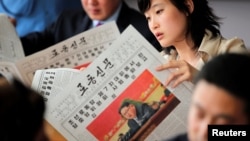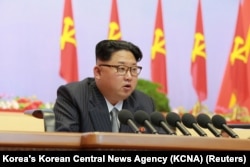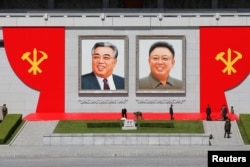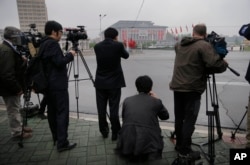North Korean President Kim Jong Un told a ruling party congress that his country would not use nuclear weapons unless its sovereignty was threatened by other nuclear powers, North Korea's state news agency said Sunday.
Kim also said he was willing to normalize relations with states that have been hostile toward the Pyongyang government, and called for more talks with South Korea to reduce distrust and the potential for further misunderstandings, the Korean Central News Agency report said.
"As a responsible nuclear weapons state, our republic will not use a nuclear weapon unless its sovereignty is encroached upon by any aggressive hostile forces with nukes," the report quoted Kim as saying.
It was unclear whether Kim's pledge indicated any change in North Korea's often belligerent attitude toward its neighbors and the United States.
In March, North Korea threatened a "preemptive" and "indiscriminate" nuclear strike on the U.S. and South Korea in response to the two nations' joint military drills.
Kim's comments to a reported 3,400 delegates came as South Korean monitors remained on high alert over the threat of further nuclear-related testing by the North in the near future.
The United Nations toughened sanctions against Pyongyang in March, after the communist state's fourth nuclear test and the launch of a long-range rocket that was widely seen as a disguised ballistic missile test.
At the congress, which opened Friday and will last several days, Kim described his five-year plan to simultaneously develop nuclear weapons and boost the country's economy.
Analysts say the plan, published Sunday in the North's Rodong Sinmun newspaper, is doomed for failure because of the heavy international sanctions North Korea will face for developing its nuclear program.
Nuclear activities
The website 38 North, which focuses on North Korean issues, said Friday that commercial satellite images taken the day before over Pyongyang's nuclear test site showed vehicle movement at a command center, where there is often no activity "except during preparations for a test."
Kim opened the seventh Workers' Party Congress on Friday by hailing the country's January nuclear test and February launch of a satellite into space, calling them demonstrations of “dignity and power at the highest level.”
“In this year of the seventh party congress, our military and people accomplished the great success in the first hydrogen bomb test and the launch of an Earth observation satellite,” Kim said.
In response, Washington called on Pyongyang to “refrain from actions and rhetoric that further destabilize the region."
Few signs of change
Kim was expected to announce major policies and the reshuffling of senior party officials during the event.
But Friday’s speech showed few signs of a dramatic change. Instead, the North Korean leader laid out a series of accomplishments that he has made since he took power in late 2011.
Kim also praised the success of so called “70-day battle,” a short-term economic campaign to maximize industrial and construction output with limited time and resources.
Since late February, the North’s state media have enhanced coverage of the campaign.
The young leader was flanked by Kim Yong Nam, president of the Presidium of the Supreme People’s Assembly and the country’s nominal head of state; and Hwang Pyong So, who holds the rank of vice marshal in the North Korean army and heads its General Political Bureau, a position considered the most powerful in the military after Kim Jong Un.
Some South Korean news organizations speculated Kim Yong Nam could be ousted after the congress.
However, some analysts in Seoul cautioned it was too early to judge the outcome of the gathering, noting the event's agenda still remained unclear.
The gathering is expected to end Monday.
The last party congress in North Korea was held when Kim's grandfather, Kim Il Sung, was president.
The current leader's father, Kim Jong Il, who rarely spoke in public, did not hold a party convention.
Lee Yeon Cheol, Kim Hwan Yong and Baik Sungwon contributed to this report, which was produced in collaboration with VOA Korean service.













